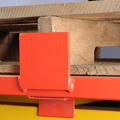Pushback rack is a high density storage system that allows you to store pallets up to 5 deep while still having access to a variety of different sku's. Pallets are loaded and unloaded in the front of the rack and each storage lane is independently accessible. A Pushback rack system allow up 75% storage capacity increase over selective racks.

Pushback rack is a high density storage system that allows you to store pallets up to 5 deep while still having access to a variety of different sku's. Pallets are loaded and unloaded in the front of the rack and each storage lane is independently accessible. A Pushback rack system allow up 75% storage capacity increase over selective racks.
Push-back racking is a lifo (last in first out) system, meaning the the first pallet load you put into the system will be the last pallet out of the system. Push-back systems have nested carts that sit in the front of the rack because the rails the sit on have a slight incline. Pushback systems can accommodate different products better than say drive-in rack because you have access to each level or lane without taking pallets out of the system.

Pushback racking is loaded and unloaded on one side. The first pallet is set on top of the cart system and will be in the first position. The forklift operator will then take the next pallet and "pushback" the first pallet into the second position. The new pallet will ride back into the second position on the top cart, revealing the second cart underneath it. When the next cart is fully revealed you let down the pallet onto it.
Now the first pallet you put into the racking system is sitting in the second position and the second pallet you put in is sitting in the front of the system. You continue this subsequent pallet loading with remaining pallets until you have fully loaded up the rack system. The first pallet you put in the system will now be the last pallet in the system and the second pallet will be in the front position.
To unload the pushback system the forklift operator will pick up the front pallet position and slowly reverse. All the pallet will slowly come down with it as you unload it because of the inclined rails.

Pushback pallet racking is used in many different applications and is an excellent choice to utilize vertical storage and increase warehouse space. It requires less space than traditional selective rack systems because you do not need as much room for aisles. If you are running out of storage space then push back racking may be something to consider.


The top cart will have a tab welded on it to keep the rear pallet from hanging off the back of the cart. It also helps when you are pushing the pallet back to keep it from sliding off.

The stop plate keeps the first cart from going off the back of the push-back pallet rack system if it is push to hard by the forklift operator.

Interlocking tabs on the pushback carts pull the cart in the forward position back as pallets are pushed back in the rack system.

The pushback cart hold down angle keeps the cart from popping off the rail system. If a pallet gets chipped or gets stuck underneath the cart, the hold down angle will not allow the cart to be lifted up.
Pushback rack is a great high density storage option. This rack system uses a lot of the same components as a selective rack system such as a rack frame and rack beams. Push back racking can be made to accommodate many different size pallets. If you have different size pallets then your cart system can be made to have supports and wire decks put on them so they do not fall through.
There are many different ways to prevent rack damage in your pushback system. Some of them are double posting the column, adding a heavy horizontal to the upright, and reinforcing the column to name a few.